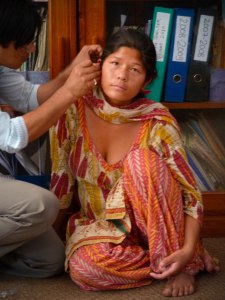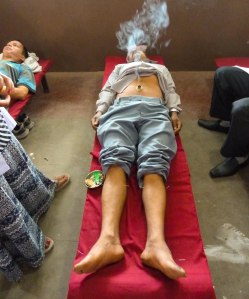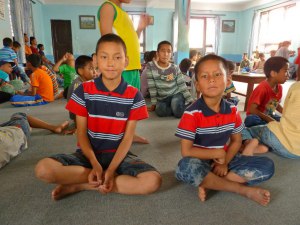
Or was it India? It’s a hot topic of debate in Asia… It seems that the Buddha was born before India and Nepal even existed as countries but the territory where he was born is (likely) modern-day Nepal. And the Nepalese are so proud to share this! Though you will find a similar argument in India; so you should do your own research I suppose. There is no doubt that the Buddha had profound influence on this part of the world, regardless of his birthplace.
This Relaxed Buddha statue pictured above was perfectly placed right outside of my apartment in Nepal so I was able to see it almost every day. It reminded me that I can have a lot on my agenda, but can choose to do it from a chaotic and tense state of mind, or from a relaxed state of mind. Ahh, so good these options are!
***
I was held up in customs for nearly an hour in the Indian airport as I was trying to leave the country, getting questioned about the acupuncture supplies I was taking with me to Nepal. “Where did they come from?” “What is your intention with those supplies?” “Exactly how many needles do you have in your bag Ms.?” Then they would just talk to teach other in Hindi and stare at my paperwork making all sorts of ahh’s, and hmm’s.. I couldn’t help but to think they were going to ask for some sort of bribe which would not have been surprising. It happens everywhere, even (and most especially) with people working in government positions. Then at some point they just got up from the table and walked out without saying anything to me. A few minutes later a young man came in to tell me that I was cleared to go. Sheesh. They hardly even looked at my passport when I arrived in India, let alone any of my paperwork I filled out on the plane to enter the country. But when I try to leave the country, they hold me up for an hour wanting to know the ins and outs of my business in Nepal!

Hiking through Budhanilkantha, countryside of Kathmandu
The transition from India to Nepal was downright liberating. Nepal is a place where I could easily travel alone and where there is a level of compassion and presence seemingly built into the fabric of their culture; perhaps through Buddhism, Tibetan or otherwise, or that they are on land with a history of war, violence, occupation and oppression. Not sure exactly what it is but that simply my movement from one country to the next was noticeably different and I felt like I could relax a bit more, even as early as being in the airport in Kathmandu. (This, of course, is not to say that all Nepali’s are compassionate or present. This is also not to say that all Nepali’s are Buddhist as there are many other religions practiced in Nepal (though mostly Buddhism and Hinduism). This is also not to say that all Buddhists are compassionate and present!)

The famous Boudhanath Stupa that I got to know really well!
The following four weeks in Nepal were filled with many adventures! As you already know as per my previous blog posts, I was there as part of Acupuncturists Without Borders research project on ear acupuncture and trauma relief and was volunteering as a consultant to check in on the various clinics they set up in Kathmandu. I was also bringing them acupuncture supplies because there is such difficulty getting them there otherwise. Ear seeds and alcohol swabs are virtually impossible to stumble across at a medical supply company. And other acupuncture supplies are extremely difficult to import because of corruption in customs. That being said, after finding a supplier in India, I was able to bring 60 boxes of ear seeds, more than 11,000 ear needles, vinyl gloves, lots of cotton rolls, several Sharps containers, lots of hand sanitizer, alcohol, face-masks, q-tips (otherwise known as cotton buds in Asia!), and more than 1,000 alcohol swabs across the border with me. This would help to keep them going for a little while longer.

A woman getting treatment at Saathi

Girls getting treatment! First they ask me, “What is YOUR caste?”
I attended many clinics in Kathmandu such as the one at Saathi, a shelter for women and children who have left situations of domestic violence, as well as the Umbrella Foundation, a home for orphans. Most of the adult or young adult clinics were enriched with somewhere between 8 and 15 participants while the children’s clinics were HUGE! At one clinic there were 90 boys between the ages of 5 to 18! I couldn’t help but to wonder what an acupuncture clinic that full of preadolescent and adolescent boys was going to be like. Could it actually be a sane environment? Would the boys relax enough to enjoy the treatment? It turned out, they loved the acupuncture! The older boys especially dropped in to the treatment and were able to relax if not take a short nap. The younger boys were also able to drop in but just not for as long as the others; 15-20 minutes max. but even they were able to report feeling “different” and “good.” What a gem it was to be able to see this group of Nepali boys enjoying ear acupuncture treatments!

Boys getting treatment!
Apart from AWB’s programs I also attended health camps at a nearby monastery (where patients were overseen by an MD-acupuncturist and acupuncture was the primary treatment modality) that were open and free to the public for 7 days in a row. Dr. Shyam who runs these clinics, is also the President of the Nepali Acupuncture Association and the key leader in charge of keeping up the clinics that AWB has set up in Kathmandu. He has a giant heart and I was so impressed with the work he is doing in Nepal. I look forward to finding ways to continue to support his work.

Dr. Shyam and I

Dr. Shyam and I doing intake for the camp

Health Camp at Anand Kuti Monastery

Dysentery treatment with moxa burning on ginger
It was Dr. Shyam that I got to spend the most time with in my acupuncture adventures there. He would ride us around the chaotic streets of Kathmandu on his motorcycle, just like most people commuting around the city. And when I say chaos, I mean chaos!At first, there are seemingly no rules to the roads but after spending so much time in the city, either commuting on foot, by taxi, or motorcycle, I realized there are in fact, many common understandings about how to drive! And while there are so many close calls and honking horns, there is also an underlying order and respect between drivers. I think the biggest thing to get used to is the closeness of other drivers. We have such large personal boundaries in the West that also extend through our cars. When someone gets within a few feet of our car or God forbid make us hit our brakes when we didn’t want to, it becomes a personal violation! But when you are in Asia, good luck trying to instate those Western boundaries! You will make yourself miserable.
***
While in Nepal, I had the luxury of being able to stay with a local Amchi and his family, (Amchi meaning “Tibetan Doctor”) in a part of Kathmandu called Boudhanath. There was one of the most famous stupa’s just a few feet from my apartment. The beautiful thing about this set up was the full-on immersion in Nepali culture which is so influenced by Bhutan, Tibet, and India. Every morning I awoke to the sounds of puja (ritual) at the stupa which began no later than 5:30 am every day of the week. It would start with drumming, chanting, incense, and the ringing of bells and would last about 30 minutes. At the same time as this was happening, kora meditation practice began which is the circumambulation of hundreds of people around the stupa that happened every day for a few hours at sunrise and then again for a few hours at sunset. For my month living in Kathmandu, this became a routine part of my life.

Kora practice in my ‘hood
My apartment sat right outside of the stupa entrance and just above the beautiful healing clinic created and sustained by Amchi Sherab and his wife, Pema who is both a massage therapist and an acupuncturist. These are two remarkable people doing heart-centered work in their community and I felt lucky to be able to spend some time with them. I was also able to work out of their clinic while I was there and even collaborate with them on the special cases. The most memorable patient was a 15 month old Nepali boy named Samrad who was born with cerebral palsy. Unfortunately in Nepal, as in many Asian countries, giving birth to babies with disabilities doesn’t come without stigma. And it is not uncommon for fathers to abandon their wives and children once it is determined that their child has a disability. Women are then left to care for their children alone in a society that largely excludes them. In India sadly, the stigma was far worse.
So Samrad’s father was working out of the country and hadn’t yet learned the news of his first and only son’s disability. Fearing abandonment, Samrad’s mother was doing everything she could to help him before the impending return of his father. That being said, she is poor and knew the Amchi’s family because she was a former cook in their household. Samrad has a type of cerebral palsy called hypotonic or flaccid CP which means that his muscles are unable to hold tone making him limp and unable to hold his head or body up or grasp with his hands. The main concerns with Samrad’s health are the vulnerability of his lungs since he can’t initiate coughing, his challenged immune system, and his non-stop crying the moment mom lays him down. Needless to say, Samrad’s mother sought refuge with Amchi Sherab’s clinic. While living there, I was able to assist them in Samrad’s treatments. And in the short time of my stay (1 month in Boudhanath), between receiving acupuncture, massage, and herbs, Samrad began to grasp and hold tight with his hands. He also began to hold his head up for the first time. His lungs had cleared up about 50% and he began to smile and giggle without being held. What a beautiful thing to witness! May his journey continue to be fruitful and full of blessings. May he be held by our Big Mother Earth and learn to trust that.

(Most of you who know me, know that I was privileged enough to work for nearly 7 years with a sweet young woman named Jodi who also had hypotonic cerebral palsy. She passed away unexpectedly in November 2012. Spending time with Samrad was particularly touching for me.)




